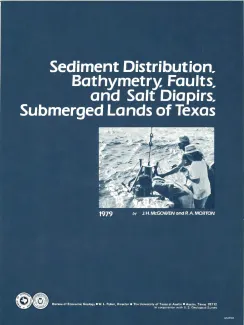
Publication Details
Geolocation:
Get the Publication
$12.00
Abstract/Description:
The State-owned submerged lands of Texas encompass nearly 6,000 square miles (15,540 km²) and extend from Mexico to Louisiana. The area includes the bays, estuaries, and lagoons, as well as the inner continental shelf 10.3 miles (16.6 km) seaward of the Gulf shoreline (fig. 1). Many uncertainties exist regarding the future utilization of the State submerged lands, and one cannot anticipate all potential uses for these areas. However, one can expect multiple and diverse uses related to food production, energy production, recreation, resource extraction, industrial processing, and transportation.
For many of these activities, initial planning requires knowledge of regional geology, active geological processes, and the potential environmental impacts of human activities.
A comprehensive investigation of State submerged lands is being conducted to develop a baseline inventory of geological and biological data for future environmental monitoring. The program was designed to provide basic scientific data necessary to assess and predict problems and potential impacts resulting from energy, mineral, transportation, recreation, and industrial development along the Texas coast and on the adjacent Federal Outer Continental Shelf. The results of this project will provide Texas with comprehensive natural resources data to assess the various development scenarios anticipated by the Texas Coastal Management Program.
Support for this comprehensive research project was provided by (1) funding from the Coastal Zone Management Program of the Texas General Land Office to the Bureau of Economic Geology (McGowen and others, 1977a) and (2) generous financial and logistical contributions made through the joint research program between the U.S. Geological Survey and the Bureau of Economic Geology.
Because the same equipment and analytical procedures are being used, data collected for the State submerged lands are compatible with data generated by the U.S. Geological Survey for the South Texas outer continental shelf as part of a study funded by the Bureau of Land Management (Berryhill, 1976). Thus, sedimentological, geochemical, geophysical, and biological data are available for South Texas coastal waters and the adjacent continental shelf extending to the shelf break. Such a massive effort was made possible through the cooperation of both research organizations and the pooling of funds, ship time, equipment, and personnel.